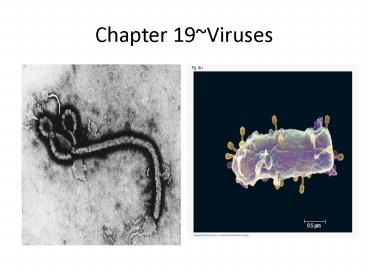Chapter 19~Viruses - PowerPoint PPT Presentation
1 / 17
Title:
Chapter 19~Viruses
Description:
Chapter 19~Viruses Viral structure Virus: poison (Latin); infectious particles consisting of a nucleic acid in a protein coat Viruses are not cells Capsid ... – PowerPoint PPT presentation
Number of Views:139
Avg rating:3.0/5.0
Title: Chapter 19~Viruses
1
Chapter 19Viruses
2
Viral structure
- Virus poison (Latin) infectious particles
consisting of a nucleic acid in a protein coat - Viruses are not cells
- Capsid (protein shell that encloses the viral
genome - built from protein subunits called capsomeres
3
Fig. 19-3
A capsid can have various structures
RNA
Membranous envelope
Head
DNA
RNA
DNA
Capsomere
Capsid
Tail sheath
Tail fiber
Capsomere of capsid
Glycoproteins
Glycoprotein
18 ? 250 nm
7090 nm (diameter)
80200 nm (diameter)
80 ? 225 nm
50 nm
50 nm
50 nm
20 nm
(a) Tobacco mosaic virus
(b) Adenoviruses
(c) Influenza viruses
(d) Bacteriophage T4
4
Viral structure
- Viral genomes may consist of either
- Double- or single-stranded DNA, or
- Double- or single-stranded RNA
- Some viruses have membranous envelopes that help
them infect hosts - These viral envelopes surround the capsids of
influenza viruses and many other viruses found in
animals
5
Concept 19.2 Viruses reproduce only in host cells
- Viruses are obligate intracellular parasites,
which means they can reproduce only within a host
cell - Each virus has a host range, a limited number of
host cells that it can infect (receptor molecules
on the surface of cells)
6
General Features of Viral Reproductive Cycles
- Once a viral genome has entered a cell, the cell
begins to manufacture viral proteins - The virus makes use of host enzymes, ribosomes,
tRNAs, amino acids, ATP, and other molecules - Viral nucleic acid molecules and capsomeres
spontaneously self-assemble into new viruses
7
Fig. 19-4
VIRUS
Entry and uncoating
1
DNA
Capsid
Transcription and manufacture of capsid
proteins
3
Replication
2
HOST CELL
Viral DNA
mRNA
Capsid proteins
Viral DNA
Self-assembly of new virus particles and
their exit from the cell
4
8
Viral reproduction Lytic Cycle
- Phages have two reproductive mechanisms the
lytic cycle and the lysogenic cycle - The lytic cycle
- 1- attachment
- 2- injection
- 3- hydrolyzation
- 4- assembly
- 5- release
- Results in death of host cell
- Virulent virus (phage reproduction only by the
lytic cycle) - Bacteria have defenses against phages, including
restriction enzymes that recognize and cut up
certain phage DNA
9
Viral reproduction Lysogenic Cycle
- Genome replicated w/o destroying the host cell
- Genetic material of virus becomes incorporated
into the host cell DNA (prophage DNA) - Temperate virus (phages capable of using the
lytic and lysogenic cycles) - May give rise to lytic cycle
10
RNA viruses
- Retroviruses transcribe DNA from an RNA template
(RNA---gtDNA) - Reverse transcriptase (catalyzing enzyme)
- HIV (human immunodeficiency virus) is the
retrovirus that causes AIDS (acquired
immunodeficiency syndrome)
11
Fig. 19-8b
Membrane of white blood cell
HIV
0.25 µm
HIV entering a cell
New HIV leaving a cell
12
- The viral DNA that is integrated into the host
genome is called a provirus - Unlike a prophage, a provirus remains a permanent
resident of the host cell - The hosts RNA polymerase transcribes the
proviral DNA into RNA molecules - The RNA molecules function both as mRNA for
synthesis of viral proteins and as genomes for
new virus particles released from the cell
13
Evolution of Viruses
- Viruses do not fit our definition of living
organisms - Since viruses can reproduce only within cells,
they probably evolved as bits of cellular nucleic
acid - Candidates for the source of viral genomes are
plasmids, circular DNA in bacteria and yeasts,
and transposons, small mobile DNA segments - Plasmids, transposons, and viruses are all mobile
genetic elements
14
Viral Diseases in Animals
- Viruses may damage or kill cells by causing the
release of hydrolytic enzymes from lysosomes - Some viruses cause infected cells to produce
toxins that lead to disease symptoms - Others have envelope proteins that are toxic
15
- Vaccines are harmless derivatives of pathogenic
microbes that stimulate the immune system to
mount defenses against the actual pathogen - Vaccines can prevent certain viral illnesses
- Viral infections cannot be treated by antibiotics
- Antiviral drugs can help to treat, though not
cure, viral infections
16
Viruses, viroids, and prions are formidable
pathogens in animals and plants
- Diseases caused by viral infections affect
humans, agricultural crops, and livestock
worldwide - Smaller, less complex entities called viroids and
prions also cause disease in plants and animals,
respectively
17
Viroids and prions
- Viroids tiny, naked circular RNA that infect
plants do not code for proteins, but use
cellular enzymes to reproduce stunt plant growth - Prions infectious proteins mad cow
disease trigger chain reaction conversions a
transmissible protein































